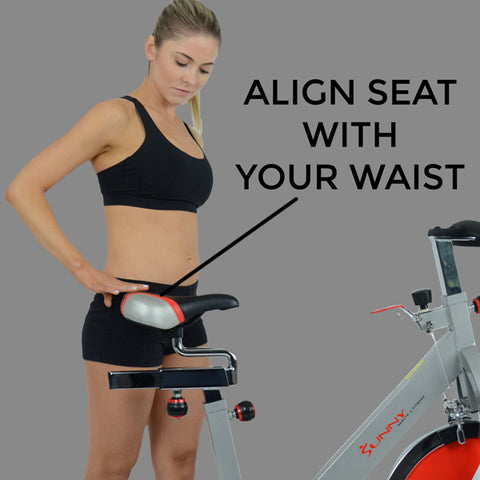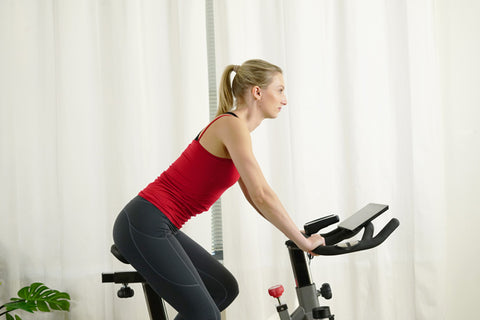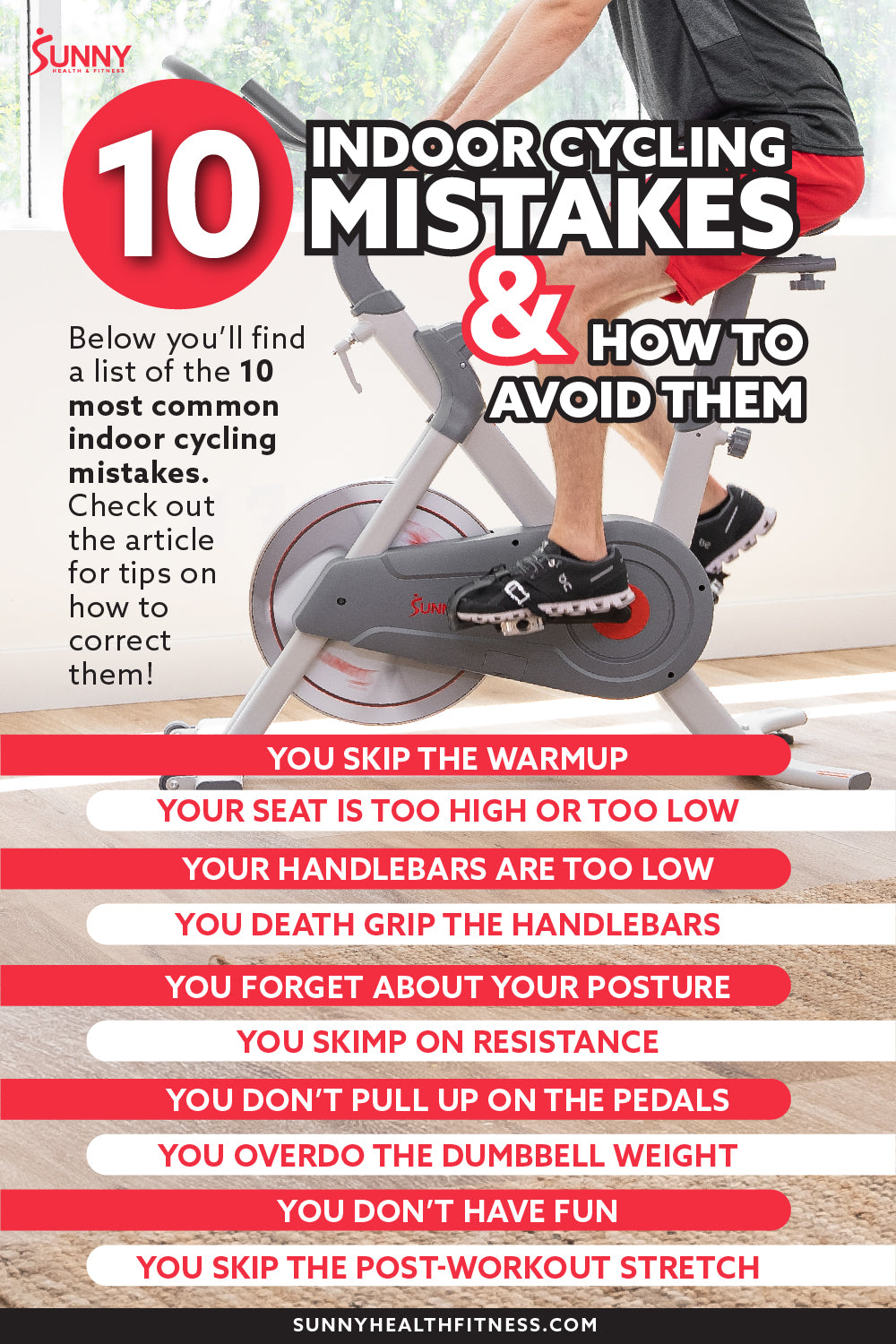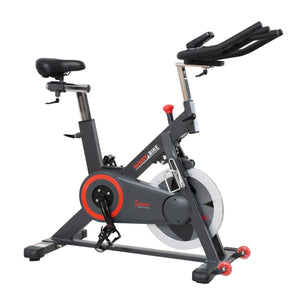Indoor cycling is an unbelievably fun way to get a heart-pumping, calorie-burning cardiovascular workout! But there are a few common mistakes I see again and again in class that may be holding you back from having an effective and safe ride. Below you'll find a list of the 10 most common indoor cycling mistakes I see as a trainer, and my top tips for how to correct them.
1. You Skip the Warmup
There's a reason instructors program a warmup into their workouts. During indoor cycling classes, it's not unusual to push your body at high resistances and heart rates. Your warmup is designed to prepare you for top performance and help protect you from injury.
The goal of your warmup is to help increase blood flow, warm up your muscles, get your heart pumping, and have you ready for anything when the workout starts. You shouldn't feel exhausted, but it's normal to start breathing and getting sweaty even during your warmup.
Fix It: If you haven't been warming up before your workouts, that's a simple fix. It's just a matter of adding 5 or 10 minutes to your workout time so you can put your best foot forward on your exercise bike. Try this 10 Minute Indoor Cycle Warm Up.
2. Your Seat is Too High or Low
How is your seat setup? If you're not sure, there's a good chance it's wrong! If your seat is too high or too low, it's going to mess with the overall efficiency of your pedal stroke and may lead to knee pain, back pain, or other injuries.

Fix It: It may take some time if you're new to cycling to find that perfect setup; take some time to get friendly with your bike. In general, your seat should be in line with the top of your hip bone when standing straight next to your bike.
Once it's adjusted, hop on and give it a test. When you pedal, your knee should be just slightly bent at full leg extension. For more tips on finding your perfect bike fit, be sure to check out our article on How to Set Up Your Sunny Cycle Bike.
3. Your Handlebars Are Too Low
When it comes to your handlebar setting, I always advise adjusting based on your comfort level. The ideal handlebar height for you is the setting that you feel most comfortable at. The main thing to stay away from when it comes to handlebars is ensuring they aren't lower than your seat, which can place unnecessary strain on your hips and back.
If you're a beginner cyclist or someone who experiences back pain, then having the handlebars set higher than your seat is probably best for you. For intermediate to advanced riders, setting the handlebars in line with your seat will challenge your core more during your ride, making it an ideal setting.
Fix It: Make sure your handlebars are adjusted at seat height or higher to avoid strain on your lower back and hips. If you're experiencing back pain or a beginner cyclist working on building core strength, feel free to set your handlebars higher than your seat to your comfort level.
4. You Death Grip the Handlebars
There is no avoiding the death grip on the handlebars - trust me when I say we've all been there. It's natural to tighten your grip on the handlebars when you're going for the gold during a climb or sprint - however, this places a ton of pressure on your fingers and wrists; and expends energy that is needed elsewhere on an action that isn't even helping you during your workout!
Fix It: Think of the handlebars as just there for your balance. Keep your grip light, wrists neutral, elbows relaxed, and focus your energy on your legs and core, the part of your body that should be doing the work!
5. You Forget About Your Posture

When you're going ham on a big hill climb or really going for it on the resistance, it's not uncommon for good posture to fly out the window. I mean, think about it, most people have a hard time practicing good posture while seated at their desk - an action that requires little to no effort on their part.
Now bring your imagination back to your bike - you're 30 minutes in and just trying to survive - are you thinking about your posture? Probably not, but you should be! Poor posture on your bike can lead to back pain, tightness, and even injuries.
Fix It: Every time you hop on your bike, practice proper posture before you even start your warmup to remind yourself what it feels like. Keep your shoulders down and away from your ears, shoulder blades pinched together behind you, chest proud, and core engaged.
During really challenging parts of the workout, bring your attention back to your posture and correct it when needed. If you need to slow down to practice proper posture, do it! Eventually, good posture will feel natural, and you'll do it without even thinking.
6. You Skimp on Resistance
When your resistance setting is too low, you may feel out of control when on your bike, and your hips may rock back and forth in your seat. You always want to be in control of your ride to make sure you're riding safely, but also to make the most of your workout.
Fix It: You should always have a base resistance, or what some cycling instructors may refer to as a flat road. Your base resistance should feel light to moderate, and you should feel very in control of your ride. Throughout your workout, base resistance should be the lowest you bring your resistance to throughout your workout to ensure you're always in control of your ride.
7. You Don't Pull Up on the Pedals
Many riders focus too much of their attention on pushing through the pedals and little attention on the backside of the rotation. When pedaling on your bike, you want to focus on maintaining even momentum throughout your pedal stroke - which means you are both pushing down on the pedals and pulling up using your hamstrings on the return as well.
Fix It: Try to maintain an even focus throughout your pedal rotation, not pushing down too hard with your quads and pulling up on the backside using your hamstrings to complete the rotation. A helpful cue for me is "dig." If you think about digging, it's a continuous motion that's dependent on the downward stroke, as well as the upward scoop.
8. You Overdo the Dumbbell Weight
You likely won't use dumbbells for every session on your indoor bike, but when you do, it's important you're using the right amount of weight for you. Upper body strength segments on the bike are designed to build muscular endurance - so they're often several minutes long, and you're repeating an exercise for a longer period of time than you would be with standard strength training off the bike. If you choose a weight that's too high, your form is likely suffering, and you run the risk of getting injured.
Fix It: Start with lightweight dumbbells - 2-5 LBs. Your weight should feel challenging towards the end of every set, but not so challenging that you have to break your posture and good form to keep moving. You can always move up to a higher weight if the weight you choose doesn't feel challenging enough.
Ready to give your dumbbells a spin during your next cycling workout? Try out this Full Body Cardio Strength Cycling Class.
9. You Don't Have Fun
Cycling is supposed to be fun! Sure, cycling requires a lot of energy, and it's not always easy – “what doesn't kill you makes you stronger,” right? But if you're not having fun, you're not doing it right.
My number one rule as a trainer is that you should always enjoy the exercise you do. There are just too many ways to exercise to force yourself to do something you don't like just to get your activity in. If you're not enjoying your sessions, it's time for a change!
Fix It: The good news is with cycling, there's an endless number of options out there to make your workouts more entertaining and fun. If you're not enjoying your workouts, continue the search for the right trainer, class style, workout playlists, and fitness tech to cater your cycling experience to you. If you need some ideas, be sure to check out my article on How to Make Indoor Cycling More Fun.
10. You Skip the Post-Workout Stretch
I started by reminding you to warmup, did you really think I was going to skip the cooldown? I am a personal trainer, after all. Cooling down after any workout is so important. Exercise is essentially putting stress on your body - working your heart, lungs, and muscles - so taking that time to slow down, stretch everything out, and pause before moving on with your day is an important practice for both your body and mind. Plus, after your workout is the best time to stretch since it's when your muscles are most warm and pliable.
Fix It:Think of cooling down as a form of self-care - it's a time to pause and be grateful to yourself for your discipline, time, and effort. If you're short on time, even a few minutes of stretching is better than nothing. Try these 5 Stretches to Cooldown After Indoor Cycling.


























Add Your Name & Email
Please enter your name and email to continue.We won’t display your email publicly.
1 comment
Do u sell a cadence monitor i can add?